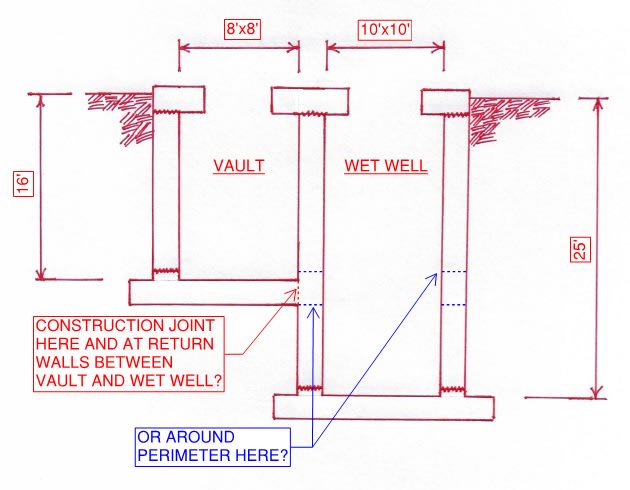Deker
Structural
- Nov 9, 2008
- 370
I'm in the process of designing a sewer lift station and don't have much experience in this arena (typically do buildings). I think I've got a good handle on what's required by ACI 350, but I'd like to get some feedback from more experienced designers when it comes to detailing and construction practices for these types of structures.
1. I'm not sure whether to locate construction joints between the vault / wet well interface or start and stop the walls so that vault and wet well walls can be poured together. Any benefits to one over the other?
2. I plan on detailing 3/8" PVC x 6" wide waterstops at the base of the walls (and at horizontal joints) and hydrophilic waterstops at the tops of the walls. If the consensus is to use a vertical joint between the vault and the wet well, what type of waterstop would you suggest?
3. I'm scratching my head over how to approach supporting the vault, but of the three options below I'm leaning toward option (c). Anything I'm overlooking?
a) Neglect bearing pressure under the vault and design the vault to "hang" from the wet well...extend the wet well slab under the vault as required for overturning.
b) Assume the vault bears on soil and design the wet well for surcharge accordingly...not sure how feasible this really is given the potential difficulties with backfilling and compacting in what could be a pretty tight excavation.
c) Specify CLSM under the vault down to the bottom of the wet well slab...eliminates surcharge on the wet well and doesn't seem too costly given the small footprint of the tank.

1. I'm not sure whether to locate construction joints between the vault / wet well interface or start and stop the walls so that vault and wet well walls can be poured together. Any benefits to one over the other?
2. I plan on detailing 3/8" PVC x 6" wide waterstops at the base of the walls (and at horizontal joints) and hydrophilic waterstops at the tops of the walls. If the consensus is to use a vertical joint between the vault and the wet well, what type of waterstop would you suggest?
3. I'm scratching my head over how to approach supporting the vault, but of the three options below I'm leaning toward option (c). Anything I'm overlooking?
a) Neglect bearing pressure under the vault and design the vault to "hang" from the wet well...extend the wet well slab under the vault as required for overturning.
b) Assume the vault bears on soil and design the wet well for surcharge accordingly...not sure how feasible this really is given the potential difficulties with backfilling and compacting in what could be a pretty tight excavation.
c) Specify CLSM under the vault down to the bottom of the wet well slab...eliminates surcharge on the wet well and doesn't seem too costly given the small footprint of the tank.






